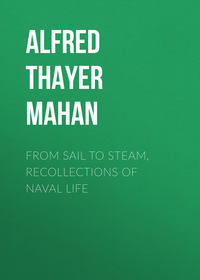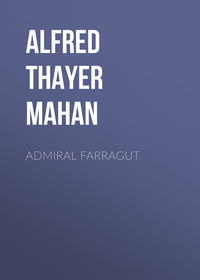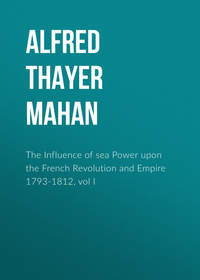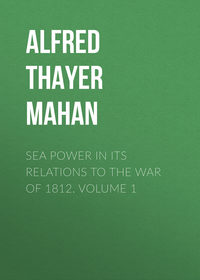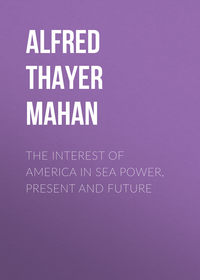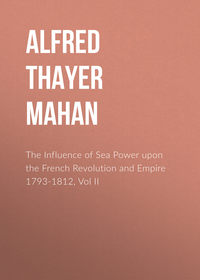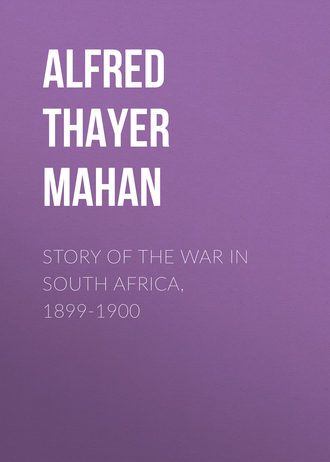 полная версия
полная версияStory of the War in South Africa, 1899-1900
The specific methods are sufficiently illustrated by the above, but it may be interesting to note the numbers sent in each succeeding month, for they show, on the one hand, the continuousness and magnitude of the operation, viewed as a whole, and also, incidentally, the December return indicates the slackening of the current, due to the unwarranted confidence of the people and of the government in the sufficiency of their preparations, and their underestimate of the difficulties before them. We in the United States during the Civil War more than once made a like mistake, discontinuing enlistments and discouraging volunteering.
In October, from the various ports of the United Kingdom, were despatched 28,763 officers and men; in November, 29,174; in December, 19,763; in January, 27,854. In the short month of February the spur of the December disasters began to show its results, for then the figures rose to 33,591; in March, with which month my information ends, 27,348 went out. The grand total, 166,277, may in its effects be summarized by saying that from October 20 to March 31, 162 days, an average of over one thousand men sailed daily from Great Britain or Ireland for the seat of war.
Some illustrations of the capacity of great ocean steamers for such service may also be interesting. Thus the "Cymric" carried a brigade division of artillery, 18 guns, 36 wagons, 351 officers and men, 430 horses, with all the ammunition and impedimenta, besides a battalion of infantry; in all nearly 1,600 men. Another, the "Kildonan Castle," took on an average 2,700 officers and men, on each of three voyages. The greatest number in any one trip was by the "Bavarian"—2,893.
In effect, although embarkation was not wholly confined to the great shipping ports, the vast majority of the vessels sailed from Southampton, the Thames, and the Mersey. At each of these was stationed a captain on the active list of the Navy, representing the Director of Transports at the Admiralty, and having under him a numerous staff of sea officers, engineers and clerks, by whom the work of equipment, inspecting, and despatching was supervised. After sailing, the vigilant eye of the Transport Department still followed them by further provision of local officials at foreign and colonial ports, and by the network of submarine telegraphs which has so singularly modified and centralised the operations of modern war. At Las Palmas in the Canary Islands, and at St. Vincent in the Cape de Verde, the intermediate coaling ports, a ship of war was kept always after October, the captains of which watched over the transports, cabling arrivals and departures, deciding questions of coal requirement, repairs, delays, and generally, no doubt, discharging the function noted by the midshipman, who explained that he must be going because he saw the first lieutenant's glass was turned his way.
At Cape Town, Port Elizabeth, and Durban were other local representatives—naval captains with staffs similar to those of the home ports—so that, to use a phrase of the Director of Transports, the ships were "well shepherded." It was, in fact, much the position of a man who with ten fingers manipulates the several keys of a piano. If the end crowns the work it may be said, although the end is not quite yet, that the work of transportation has been crowned. No loss of human life by preventable cause has occurred, nor has complaint been heard of serious hitch of any kind. The numbers speak for themselves.
The carriage of animals necessary for an army of the numbers transported would in any case be a weighty and troublesome task, but it has been rendered doubly so by the scanty resources of the scenes of war, by the terrible horse-sickness, and by the length of the voyage, which enfeebles the animals in a proportion ever increasing with the passage of the days. The evil becomes yet greater from the pressing needs at the front, and the importunate urgency to hasten the animals forward, over a railroad journey of hundreds of miles, without first giving them time to regain the fulness of their strength.
The importance and embarrassing nature of this factor in the campaign are hard to overestimate. The insufficient number of horses and their debility have doubtless accounted for much of the delay and seeming languor of action, which has appeared otherwise inexplicable; the utter weakness of the poor beasts having indeed been expressly alleged as the reason for failure of cavalry or of artillery in more than one critical moment. That the supply forwarded has been large, if nevertheless falling short of the demand, is shown by the transport figures, according to which, in round numbers, 50,000 horses and 39,000 mules had been shipped by the end of March. Half of the former, and the greater part of the latter, were drawn from North and South America, from Australia, and from the Mediterranean. To these figures is to be added another, yet uncertain because future, but which, when ascertained, will probably double the number of horses and mules actually used in the war, raising it, including those obtained in South Africa itself, to nearly 200,000. The monthly waste has been roughly reckoned at 5,000.
The size and multiplicity of these various operations enforce the homely, but always to be remembered, maxim that "War is business," and that in all its aspects; business in which, like every other, the aim must be the best results with the least expenditure—of money, of labour, and of life. An intermediate difficulty in the problem of getting men, horses, and supplies from England to the front of operations, and one which probably would not antecedently occur to a person inexperienced in such transactions, was the inadequate facilities at Cape Town itself, as well as of the railroads, for handling the mass of freight, animate and inanimate, unexpectedly thrust upon them. A third-class port cannot be suddenly raised to the business of one of the first class, and be found either competent or convenient. Consequently, the congestion at the docks, wharves, and railroads was very great. Many ships were kept waiting two months, or even more, for discharge; a fact which means not merely expense, though that is bad enough, but delay in operations, which in turn may be the loss of opportunity—and the equivalent of this again is prolongation of war, loss of life, and other miseries.
The practical lesson of this embarrassment at Cape Town should not be lost to those who assume too lightly that the traffic of the Suez Canal can in time of war be turned to the Cape route. The question of necessity for coaling at Cape Town, and the facilities for it should at least be exhaustively studied before accepting this solution as final, or even probable. It is evident that, for the operations of this war, the use of Port Elizabeth, Port Alfred, and East London, although they have no docks at which steamers can lie and discharge, would to some extent relieve Cape Town; but that such relief should be effective at the front, it was necessary also that the railroads from them should be securely held up to their junctions with the main line. This was not the case at first.
It may be added, for the benefit of American readers, that this question of local congestion, and of consequent dislocation and delay of traffic and of transport, is worthy of consideration by those among us who may think that the interruption of our coasting trade, or the blockade of one or two principal harbours, can be met by transferring the business, of the former to the railroads, of the latter to other ports not blockaded. This is not so, because the local conveniences and methods, which have developed under the sifting tests of experience and actual use, cannot be transferred at short notice; and until such transfer has been made, distribution cannot proceed. The body economic and commercial will be in the state of the body physical whose liver is congested, whose blood therefore circulates poorly, with consequent imperfect nutrition and general disorder of the system; much where little ought to be, and little where much.
CHAPTER IV
THE WESTERN FRONTIER TO MAGERSFONTEIN AND STORMBERG—OPERATIONS OF GENERAL FRENCH ABOUT COLESBERG
As was the case a century ago, on the eve of the French Revolution, Great Britain last year indulged too long her dream of peace, and awaked from it too late for timely preparation. Like a man who starts behindhand with his day, the catching up meant double worry, if not double work. Hildyard's brigade, which sailed October 20, had, thirty days before, been preceded by two hospital ships, three batteries of field artillery and a thousand infantry;7 the last-named getting away on the 19th, only one day before Hildyard. No British field troops had then reached South Africa, save a couple of battalions additional to Cape Colony, and the reinforcements to Sir George White drawn mainly from India, which, with most of his corps in Natal, and despite his well-directed energy, the Boers by their superior numbers were able to round up and corral in Ladysmith in three weeks after their ultimatum was issued. There were then also on the way some fifteen hundred of the Army Service Corps, an organised body of men trained for the supply and transport service of the army, and of skilled mechanics, whose duties are to construct and maintain works of various kinds for the facilitation of army supply—transport and depot. These had sailed in the early days of October.
Such was the mighty enginery antecedently set in motion, to crush the liberties of the Transvaal. An interesting further illustration of the way decision was precipitated toward the end is found in the fact that Sir George White was gazetted Governor of Gibraltar in the last week in August, and on September 15 sailed to command the forces in Natal.
"My small experience," wrote Steevens about October 12 from the well-advanced station of Stormberg Junction, in Cape Colony, "has been confined to wars you could put your fingers on; for this war I have been looking long enough and have not found it.... We are heavily outnumbered, and have adopted no heroic plan of abandoning the indefensible. We have an irregular force of mounted infantry at Mafeking, a regiment (regulars) at Kimberley, a regiment and a half at De Aar" (the most important of junctions), "half of the Berkshires at Naauwport, the other half here." Stormberg and Naauwport were also junctions, secondary only, if secondary, to De Aar, in the strategic importance that always attaches to cross-roads. "The famous fighting Northumberlands came crawling up behind our train, and may now be at Naauwport or De Aar. Total, say, 4,100 infantry, of whom 600 mounted; no cavalry, no field guns. The Boer force available against these isolated positions might be very reasonably put at 12,000 mounted infantry, with perhaps a score of guns.... It is dangerous—and yet nobody cares. There is nothing to do but wait—for the Army Corps that has not yet left England. Tiny forces, half a battalion in front, and no support behind—nothing but long lines of railway with ungarrisoned posts hundreds of miles at the far end of them. It is very dangerous. No supports at this moment nearer than England."8
In this brief and pregnant summary the reader will note outlined the elements characteristic of all strategic situations: the bases, the seaports; the communications, the railway lines; the front of operations, the frontier of the Orange Free State, or rather, perhaps, in this defensive—or defenceless—stage, the railroad line parallel to it, which joins De Aar, Naauwport and Stormberg.
Dangerous, sure enough; how much so needs only a glance at the map to show. Before reinforcements could arrive Sir George White was shut up in Ladysmith by forces double his own. These he held there, it is true; and the fatal delay of the Boers before his lines, reflected in their no less fatal inactivity on the frontier of the Cape Colony, whence Steevens wrote the words quoted, doubtless threw away the game; but we are now speaking, as he was then writing, of the time when the cards had only been dealt and the hand was yet to play. Put your marks on each of the places named—Mafeking, Kimberley, De Aar, Naauwport, Stormberg—note their individual and relative importance, the distances severing them from one another, the small bodies of men scattered among them, incapable through weakness and remoteness of supporting each other, and with no common supports behind. Mafeking is from Kimberley 223 miles; Kimberley from De Aar, 146; De Aar from Naauwport, 69; Naauwport from Stormberg 80, as the crow flies over a difficult country, at least 130 by rail. All three junctions with their intervening lines of rail, bridges, culverts and all, are little over fifty miles from the Orange River, which hereabout forms the boundary separating Cape Colony from the Free State. And White is about to be invested in Ladysmith, and the Army Corps has not yet left England.
The average length of a transport's voyage from the United Kingdom to Cape Town, as determined from 162 records, was 22-1/6 days. The first, with Hildyard's brigade, accomplished it in 20 days, arriving November 9; the last of the four took 25 days, coming in on the 14th. With them, and their one predecessor, 6,000 additional troops were at the latter date—five weeks after the Boers' ultimatum became operative—landed at the far base of operations, yet 500 miles by railroad from the front. Kimberley and Mafeking were then already invested, and the bombardment at both places begun. The British troops had evacuated Stormberg Junction November 3, falling back to the southward toward Sterkstrom and Queenstown; thus abandoning railroad communication between East London, one of the sea bases, and the western theatre of war toward Naauwport and De Aar. Naauwport had also been quitted at about the same time, but the Boer grasp in that central quarter was never as firm as it was to the eastward and westward. General French was early established with his cavalry at Hanover Road, midway on the line from Naauwport to De Aar, and his activity, skilfully directed against the flanks of the enemy, imparted to the latter a nervousness which the frontal attacks on the eastern line failed to produce. Naauwport was reoccupied by the British November 19, and De Aar was never by them abandoned; but the Boers on the 25th of November blew up a bridge on the line from Naauwport via Middelburg and Rosmead to Port Elizabeth, thereby momentarily cutting out the line from this sea base also, as their advance upon Stormberg had eliminated East London. They made also strenuous efforts, at many points, to destroy the main road from Kimberley south to Orange River, blowing up culverts and bridges, but the damage effected was afterward found to be less than had been expected, owing to the clumsiness of their methods; a fact which probably indicates that their cause was supported mainly by a rural population, and that few mechanics—townsfolk—were in their ranks.
There seems to have been no serious attempt to interrupt communications south of the Orange River, important though it was to do so. The British Corps, to the command of which Lord Methuen was assigned, assembled at the Orange River Bridge without opposition or difficulty, its concentration being effected on the 19th of November. The advance thence, in fact, began on the 21st, and on the 23rd was fought its first battle, that of Belmont.
It will be well here to summarize, map in hand, the character and result of the Boers' operations in this western theatre, during the priceless five weeks of opportunity secured to them by the over-confidence, or the remissness, or the forbearance, of their powerful enemy. The conditions differed from those in the eastern scene of war—in Natal—because there the just anxiety of the inhabitants, reflected in that of the colonial and Imperial governments, had occasioned the concentration of by far the greatest mass of available British troops.
The exposure of Natal in its more vital and strictly British interests greatly exceeded that of Cape Colony, where, owing to the remoteness of the seaboard, near which the British chiefly congregated, the first of the Boer invasion would fall upon a population strongly sympathetic with the cause of the enemy, though British in allegiance. Therefore while this disloyalty was ominous and detrimental to the British cause as a whole, direct injury to British interests was less immediately threatened. The Cape frontier, accordingly, was left defenceless, as has been shown; and in a strictly military point of view it was quite correct thus wholly to neglect one, rather than weakly to divide between two.
The consequence was that in Natal occurred during ten days the severe and nearly continuous fighting already narrated, with the result of shutting up in Ladysmith, on the direct line of any further advance contemplated by the Boers, a very strong British force; incapable, doubtless, of taking the field against the vastly superior numbers confronting it, but most capable, by numbers and position, of embarrassing any onward movement of the enemy. This aspect of the case has been too much neglected in the general apprehension.
The British in Ladysmith were doubtless an isolated and endangered garrison, the relief of which constrained the movements of its friends away from more proper objectives; but in the early days of the siege, while in the prime of the physical strength afterward drained away by hunger, and up to the time that reinforcements had arrived to bar in front the progress of the enemy, it was also to the latter what Mantua in 1796 was to Bonaparte, and Genoa in 1800 was to the Austrians prior to Marengo—a force which, if advance were attempted, would be on the rear of the army, flanking the communications. To secure these it would be necessary, before forward movement, either to carry the place by assault, suitably prepared and executed, thus sweeping it out of the way for good, or else to keep before it a detachment of sufficient strength to check any effort seriously to interrupt the communications. But this would be to divide the Boer forces, to which doubtless Joubert did not feel his numbers adequate. This was the important—the decisive—part played by Ladysmith in the campaign.
Had the Boers' "exclusiveness of purpose"—to use Napoleon's happy phrase—answered to the demands of their military situation, they would have done for military reasons what their opponents were compelled to do through unpreparedness and considerations of civil policy. They would have neglected the frontiers of Cape Colony, and concentrated their effort against the organised force which exceptionally favourable circumstances, that could not be expected either to continue or to recur, had enabled them to isolate in Natal.
What effect the failure to do this produced in the latter colony will be examined later. We have now to consider how the Boers, having decided to follow two widely divergent plans of operations, utilised the opportunity afforded them by the long period of weakness undergone by their antagonists in the debatable ground, where the frontiers of Cape Colony and the Orange Free State adjoin, along the banks of the Orange River from Basutoland to Kimberley. Remote and detached Mafeking, the news of whose deliverance comes as these lines are writing, remains a romantic episode, a dramatic centre of interest, from the heroic endurance and brilliant gallantry displayed by its garrison; but, from the practical side, the action of friend and foe, the fact of occupation and the conduct of the siege, present a military riddle not readily solved.
Noting the natural military line of the Orange River, the importance of which in more military countries would be emphasized by corresponding works of precaution, for defence and for movement, in its vicinity, it will be observed that parallel to it, at a distance of about fifty miles, within the borders of the colony, there is the stretch of railway from Stormberg, via Rosmead Junction and Naauwport, to De Aar. Beyond the last-named point the line, now become the main road, converges steadily and rapidly upon the border of the Free State, within a dozen miles of which it continues from the point where it crosses the Orange River until abreast the boundary between the Free State and the Transvaal. Between Stormberg and De Aar this line consists simply of the branches that there tie together the main roads, through which the principal seaports—Cape Town, Port Elizabeth, and East London—seek access to the interior. The direction, alike of the main and branch roads, as well as the position of the junctions, are doubtless determined by local considerations of topography and traffic.
Although constructed for commercial purposes, the line of rail from Stormberg to De Aar has particular military value as an advanced base of operations, from which to start, and upon which, for the initial stages, to rest a campaign. It is central as regards the extremities of the hostile frontier opposed to it; it is moderate in length; and, from the rapidity of transfer from end to end afforded by the railroad, it permits movements on one flank or the other to be combined with comparative facility. Add to this the convergence upon it of the several lines of supply from Cape Town, Port Elizabeth and East London, and it is evident that the line would present particular advantages for the assembling of a British army intending to invade the Free State by the most probable, because most advantageous, route, the direct highroad to Bloemfontein. It is, indeed, the key, the central military position of this theatre of war; not geometrically, by mere measurement of distance, but as the place where converge and unite all the great communications from the opposing bases of operations, which at the first would be, for the Free State, the Orange River, and for Great Britain, the line of seaports.
The distance from the frontier and the interposition of the mountain range in the Steynsburg district would combine to make observation of preliminary movements difficult to the enemy, except, indeed, by information from the disaffected inhabitants who abounded. The secure and undisturbed tenure of this line would therefore much facilitate the British campaign, should it develop against the Free State; consequently the first aim of the Boer commanders should have been to hold, or if not able to hold, to destroy it effectually as regards steam communication.
It is as yet impossible to say exactly what was the force of the Boers on their western frontiers between the middle and the end of October. Steevens, as above quoted, thought 12,000 at the earlier date. A more likely reckoning seems to me to be 8,000, but it probably rose near the higher figure before November, and must much have exceeded it by the 1st of December, unless British estimates are more wide of the mark than is probable. The lowest maximum for the forces of the two republics that I have seen was given by one of the Boer envoys now9 in the United States; viz., 38,000. Allowing 30,000 to Natal by November 1, there is nothing immoderate in the supposition that there were then from 10,000 to 12,000 on the line of the Orange River, and from thence round to Mafeking. Personally, I believe that the totals were larger, for very considerable numbers of the Dutch population in Cape Colony and Natal joined the Boers, and the indications are that all the available men were put—and very properly—at once in the field. The emergency was great, time was invaluable, and the maintaining of a reserve, judicious in many cases, would under the conditions of the Boers have been a mere dividing and frittering of forces, by the immediate employment of which alone might success be snatched.
To allow Great Britain time to arouse, to assemble and put forth her strength, before some really decisive advantage, material or moral, was gained over her, was to ensure defeat. This, however, was what the Boers did. Although they put in force successfully a levée en masse, and thus in point of time concentrated into action their whole fighting population, they did not with equal exclusiveness of purpose concentrate in force upon a single military objective; nor was such choice as they made dictated by sound military principle, or carried out with sound military judgment.
It so happened that the conditions at the opening of the campaign bore a curious resemblance, though on a considerably larger scale, to those attending the hostilities of 1881 in South Africa. Then, as now, the British were in number far inferior. Then, as now, they were scattered here and there in small detachments. Then the Boers had achieved successes which doubtless surprised themselves as well as their enemies, and had produced for them the unfortunate result of overvaluing their own prowess, and of inducing a secure belief that both they and their opponents, after twenty years, remained in native and acquired qualities in the same relative positions of individual superiority and inferiority that they had somewhat prematurely assumed.




